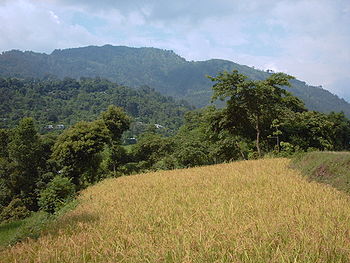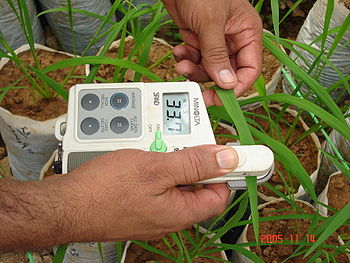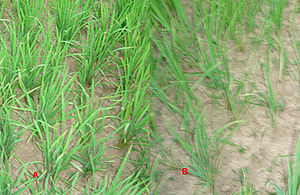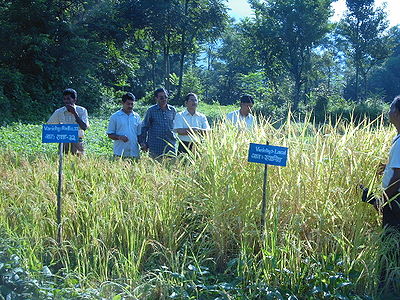
Upland rice
Encyclopedia
Upland rice is rice
grown on dry soil. Most rice is grown in flooded rice paddies
.
as their daily staple food. Almost two-thirds of the upland rice area is in Asia
. Bangladesh, Cambodia, China, India, Indonesia, Myanmar, Thailand, and Vietnam are important producers.
Upland rice is grown in rainfed fields prepared and seeded when dry, much like wheat
or maize
. The ecosystem is extremely diverse, including fields that are level, gently rolling or steep, at altitudes up to 2,000 metres and with rainfall ranging from 1,000 to 4,500 mm annually.
Soils range from highly fertile to highly weathered, infertile and acidic, but only 15 percent of total upland rice grows where soils are fertile and the growing season is long.
Many upland farmers plant local rices that do not respond well to improved management practices -- but these are well adapted to their environments and produce grains that meet local needs.
Although the rice technology of the 1960s and 70s focused on irrigated rice, farmers in the uplands were not forgotten. Researchers produced cultivars adapted to poor soils, and with improved blast resistance and drought
tolerance. Some have outyielded traditional rices by more than 100 percent in evaluations. Scientists at national agricultural research systems have crossed these improved rices with local cultivars and farmers are now beginning to grow the progeny. But more improvements are needed to meet the new challenges.
 Population growth, the demands of urbanism and industry, and the increasing adoption of high value cash crop farming in the surrounding lowlands are leading to strong competition for upland terrain.
Population growth, the demands of urbanism and industry, and the increasing adoption of high value cash crop farming in the surrounding lowlands are leading to strong competition for upland terrain.
The uplands have traditionally suffered from drought and infertile soils, weeds and plant diseases. Soils there have been badly eroded and degraded as a result of the slash-and-burn agriculture that for many years followed logging. This, in turn, destroys the watershed, producing problems in the lands below.
Already the new upward pressures are resulting in a movement toward permanent agriculture and intensification of land use in upland areas. Those involved find themselves faced -- in addition to the usual upland problems -- with an urgent need to conserve the soil and the diversity of plant species, and to cope with increasingly frequent and severe weed and disease infestations.
of resistance to the Blast fungus, one of the most damaging diseases of rice, and are using the techniques of biotechnology to develop cultivars with more durable disease resistance.
In the uplands, blast is particularly important because the environment favors its proliferation. Although many traditional upland cultivars show stable resistance to this disease under low-input cropping practices, they have other characteristics that make them difficult to use in intensified systems. So the risk from blast increases as cropping practices intensify and improved varieties are introduced.
IRRI scientists have been working with colleagues in the Upland Rice Research Consortium to better understand pathogen populations and to identify resistance genes found in some cultivars. Armed with this knowledge, they are working with IRRI's upland rice breeder to combine such genes with other desirable traits for incorporation into new upland varieties.
Consortium scientists are also trying to understand how upland rice farmers' cropping systems contribute to soil erosion, with the aim of proposing possible erosion control techniques. Studies in the Philippines
have shown, for example, that hedgerows of trees, shrubs and grasses along hill contours can help reduce soil erosion up to 90 percent. Rice or other crops are planted between these strips of permanent ground cover.
Leguminous plants in hedgerows make substantial amounts of atmospheric nitrogen
available to both riceplants and annual crops and recycle other nutrients and organic matter.
Such legumes can simultaneously increase farmers' incomes and contribute to sustainability of the farming system.

Most weed species also are victims of their own diseases. Purposeful application of the agents of such diseases to weed pests among rice crops could constitute another approach to weed control.
Researchers from IRRI, Maejo University and Chiang Mai University launched a study in 1993 of the interactions between weeds, crop environmental conditions, and farmers' practices in upper northern Thailand. The goals are to understand the diversity of farmers' practices and decisionmaking processes and to grade the factors that limit rice crop yields.
IRRI scientists are also studying how fertilizer and cultural practices influence weed communities. In one project on phosphorus management, they are investigating how weed communities change as soil fertility is improved over time in the Philippines, Indonesia, and Thailand.
Riceplant cultivars differ in their ability to compete with weeds in the field. Scientists in the Philippines tested the competitiveness of a dozen cultivars against weeds to help farmers choose the most highly competitive one. By planting this cultivar and enhancing its competitive ability through good management practices, farmers should be able to reduce the number of handweedings necessary while achieving maximum yields.

But the scientists found that the lack of phosphorus will limit production even if calcium is added to the soil to overcome the acidity, or if acid-tolerant cultivars are planted. Rotations of rice and legumes could lead to stable, higher value production, they concluded. But first it is necessary to ensure by adding phosphorus that soil quality does not degrade over time.
Eventually, the investment in soil inputs should pay off as added phosphorus exceeds crop needs and as other nutrients such as carbon and nitrogen are better cycled and used.
At present they are studying the processes that govern the rate of leaching of lime components and their accumulation in the subsoil. They plan then to construct mathematical models that will be used to develop practical technologies and to indicate under what conditions the technologies might be effective.
The experiments began at the Upland Rice Research Consortium site at Sitiung, Indonesia. French collaborators from l'Institut francais de recherche scientifique pour le developpement en cooperation are planning similar experiments in Thailand and Vietnam.
species from Southeast Asia, but their yields are low. These species, however, can be crossed with cultivated rice.
The challenge facing scientists is to produce a high-yielding perennial plant adapted to the poor soils of the uplands, and one that is highly responsive to low amounts of purchased inputs, and that resists diseases and insect pests.
It's a challenge IRRI scientists are currently working on. New biotechnology tools will be used to transfer the perennial characters into cultivated rice, and new knowledge of genetic diversity will be applied to develop pest resistance.
See: Developing Perennial Upland Rice I: Field Performance of Oryza sativa/O. rufipogon F1, F4, and BC1F4 Progeny. Crop Sci. 43:120–128

Rice
Rice is the seed of the monocot plants Oryza sativa or Oryza glaberrima . As a cereal grain, it is the most important staple food for a large part of the world's human population, especially in East Asia, Southeast Asia, South Asia, the Middle East, and the West Indies...
grown on dry soil. Most rice is grown in flooded rice paddies
Paddy field
A paddy field is a flooded parcel of arable land used for growing rice and other semiaquatic crops. Paddy fields are a typical feature of rice farming in east, south and southeast Asia. Paddies can be built into steep hillsides as terraces and adjacent to depressed or steeply sloped features such...
.
Introduction
Nearly 100 million people now depend on upland riceRice
Rice is the seed of the monocot plants Oryza sativa or Oryza glaberrima . As a cereal grain, it is the most important staple food for a large part of the world's human population, especially in East Asia, Southeast Asia, South Asia, the Middle East, and the West Indies...
as their daily staple food. Almost two-thirds of the upland rice area is in Asia
Asia
Asia is the world's largest and most populous continent, located primarily in the eastern and northern hemispheres. It covers 8.7% of the Earth's total surface area and with approximately 3.879 billion people, it hosts 60% of the world's current human population...
. Bangladesh, Cambodia, China, India, Indonesia, Myanmar, Thailand, and Vietnam are important producers.
Upland rice is grown in rainfed fields prepared and seeded when dry, much like wheat
Wheat
Wheat is a cereal grain, originally from the Levant region of the Near East, but now cultivated worldwide. In 2007 world production of wheat was 607 million tons, making it the third most-produced cereal after maize and rice...
or maize
Maize
Maize known in many English-speaking countries as corn or mielie/mealie, is a grain domesticated by indigenous peoples in Mesoamerica in prehistoric times. The leafy stalk produces ears which contain seeds called kernels. Though technically a grain, maize kernels are used in cooking as a vegetable...
. The ecosystem is extremely diverse, including fields that are level, gently rolling or steep, at altitudes up to 2,000 metres and with rainfall ranging from 1,000 to 4,500 mm annually.
Soils range from highly fertile to highly weathered, infertile and acidic, but only 15 percent of total upland rice grows where soils are fertile and the growing season is long.
Many upland farmers plant local rices that do not respond well to improved management practices -- but these are well adapted to their environments and produce grains that meet local needs.
Although the rice technology of the 1960s and 70s focused on irrigated rice, farmers in the uplands were not forgotten. Researchers produced cultivars adapted to poor soils, and with improved blast resistance and drought
Drought
A drought is an extended period of months or years when a region notes a deficiency in its water supply. Generally, this occurs when a region receives consistently below average precipitation. It can have a substantial impact on the ecosystem and agriculture of the affected region...
tolerance. Some have outyielded traditional rices by more than 100 percent in evaluations. Scientists at national agricultural research systems have crossed these improved rices with local cultivars and farmers are now beginning to grow the progeny. But more improvements are needed to meet the new challenges.
Upland rice farmers' challenges
New challenges are emerging in the world's upland rice farming areas, where already some of the world's poorest farmers try to wrest a living from fragile soils that are fast being degraded.
The uplands have traditionally suffered from drought and infertile soils, weeds and plant diseases. Soils there have been badly eroded and degraded as a result of the slash-and-burn agriculture that for many years followed logging. This, in turn, destroys the watershed, producing problems in the lands below.
Already the new upward pressures are resulting in a movement toward permanent agriculture and intensification of land use in upland areas. Those involved find themselves faced -- in addition to the usual upland problems -- with an urgent need to conserve the soil and the diversity of plant species, and to cope with increasingly frequent and severe weed and disease infestations.
Fighting the Blast fungus
Recently, scientists have been improving their knowledge of the geneticsGenetics
Genetics , a discipline of biology, is the science of genes, heredity, and variation in living organisms....
of resistance to the Blast fungus, one of the most damaging diseases of rice, and are using the techniques of biotechnology to develop cultivars with more durable disease resistance.
In the uplands, blast is particularly important because the environment favors its proliferation. Although many traditional upland cultivars show stable resistance to this disease under low-input cropping practices, they have other characteristics that make them difficult to use in intensified systems. So the risk from blast increases as cropping practices intensify and improved varieties are introduced.
IRRI scientists have been working with colleagues in the Upland Rice Research Consortium to better understand pathogen populations and to identify resistance genes found in some cultivars. Armed with this knowledge, they are working with IRRI's upland rice breeder to combine such genes with other desirable traits for incorporation into new upland varieties.
Consortium scientists are also trying to understand how upland rice farmers' cropping systems contribute to soil erosion, with the aim of proposing possible erosion control techniques. Studies in the Philippines
Philippines
The Philippines , officially known as the Republic of the Philippines , is a country in Southeast Asia in the western Pacific Ocean. To its north across the Luzon Strait lies Taiwan. West across the South China Sea sits Vietnam...
have shown, for example, that hedgerows of trees, shrubs and grasses along hill contours can help reduce soil erosion up to 90 percent. Rice or other crops are planted between these strips of permanent ground cover.
Leguminous plants in hedgerows make substantial amounts of atmospheric nitrogen
Nitrogen
Nitrogen is a chemical element that has the symbol N, atomic number of 7 and atomic mass 14.00674 u. Elemental nitrogen is a colorless, odorless, tasteless, and mostly inert diatomic gas at standard conditions, constituting 78.08% by volume of Earth's atmosphere...
available to both riceplants and annual crops and recycle other nutrients and organic matter.
Such legumes can simultaneously increase farmers' incomes and contribute to sustainability of the farming system.

The importance of weeds
Weeds are the most serious biological constraint to upland rice production. IRRI scientists are pursuing projects on managing weeds with less herbicide use. One approach is to search for rice plant species that exhibit a characteristic known as allelopathy. Allelopathic plants can affect the growth of nearby plants through the production of biological compounds they release into the environment. If an allelopathic rice -- or other plant species -- could be found that could inhibit the growth of weeds important in rice production, it might be possible through genetic engineering to develop rice cultivars that would provide their own weed control.Most weed species also are victims of their own diseases. Purposeful application of the agents of such diseases to weed pests among rice crops could constitute another approach to weed control.
Researchers from IRRI, Maejo University and Chiang Mai University launched a study in 1993 of the interactions between weeds, crop environmental conditions, and farmers' practices in upper northern Thailand. The goals are to understand the diversity of farmers' practices and decisionmaking processes and to grade the factors that limit rice crop yields.
IRRI scientists are also studying how fertilizer and cultural practices influence weed communities. In one project on phosphorus management, they are investigating how weed communities change as soil fertility is improved over time in the Philippines, Indonesia, and Thailand.
Riceplant cultivars differ in their ability to compete with weeds in the field. Scientists in the Philippines tested the competitiveness of a dozen cultivars against weeds to help farmers choose the most highly competitive one. By planting this cultivar and enhancing its competitive ability through good management practices, farmers should be able to reduce the number of handweedings necessary while achieving maximum yields.

Improving soil fertility
Research on farms in Thailand, Laos and the Philippines has confirmed what scientists had long suspected: that a lack of phosphorus in upland farms is limiting rice crop yields. Their suspicions arose from the fact that many highly weathered upland soils are inherently low in phosphorus and are acidic.But the scientists found that the lack of phosphorus will limit production even if calcium is added to the soil to overcome the acidity, or if acid-tolerant cultivars are planted. Rotations of rice and legumes could lead to stable, higher value production, they concluded. But first it is necessary to ensure by adding phosphorus that soil quality does not degrade over time.
Eventually, the investment in soil inputs should pay off as added phosphorus exceeds crop needs and as other nutrients such as carbon and nitrogen are better cycled and used.
Breaking the acid barrier
The acidity present in the subsoil of many upland areas prevents plant roots from reaching the moisture and nutrients therein, thus reducing crop yield. Adding lime to the subsoil is not practical, but in 1994 IRRI and Indonesian scientists began experiments to see if components of lime applied to the soil surface could be leached down into the subsoil. This would be done by manipulating soil chemistry and using deep-rooted, acid-tolerant rice cultivars to help capture the leached components.At present they are studying the processes that govern the rate of leaching of lime components and their accumulation in the subsoil. They plan then to construct mathematical models that will be used to develop practical technologies and to indicate under what conditions the technologies might be effective.
The experiments began at the Upland Rice Research Consortium site at Sitiung, Indonesia. French collaborators from l'Institut francais de recherche scientifique pour le developpement en cooperation are planning similar experiments in Thailand and Vietnam.
A perennial upland rice plant?
A rice plant that would not have to be planted annually could help reduce erosion by providing a permanent ground cover. Perenniality exists in several wild riceWild rice
Wild rice is four species of grasses forming the genus Zizania, and the grain which can be harvested from them. The grain was historically gathered and eaten in both North America and China...
species from Southeast Asia, but their yields are low. These species, however, can be crossed with cultivated rice.
The challenge facing scientists is to produce a high-yielding perennial plant adapted to the poor soils of the uplands, and one that is highly responsive to low amounts of purchased inputs, and that resists diseases and insect pests.
It's a challenge IRRI scientists are currently working on. New biotechnology tools will be used to transfer the perennial characters into cultivated rice, and new knowledge of genetic diversity will be applied to develop pest resistance.
See: Developing Perennial Upland Rice I: Field Performance of Oryza sativa/O. rufipogon F1, F4, and BC1F4 Progeny. Crop Sci. 43:120–128
Participatory crop improvement
Upand rice has been replaced by other crops such as maize in onehand, in the other hand hand the landraces has been no more in farmers' field. Diversity of upland rice can be maintained at the sametime level of production can be increased using participatory techniques.

